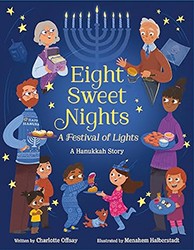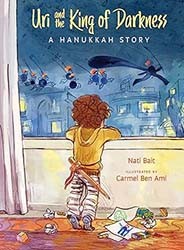The instantly recognizable Golden Book brand has existed for more than seventy-five years; the holiday of Hanukkah has been around for much longer. These two classics meet in Bonnie Bader and Joanie Stone’s lovely picture book about the Jewish holiday. With a simple text alternating between contemporary celebration and historical background, with vibrantly colored pictures, Hanukkah: The Festival of Lights, teaches young children about the festival’s significance and also captures the warmth and excitement of one family’s observance.
The book begins with the most familiar of facts. Hanukkah is called the Festival of Lights and involves lighting the eight-branched menorah. This Golden Book sticks with the most typical American, and Ashkenazic, customs, including eating potato latkes and giving gifts, although these appear only as wrapped packages, with no scene of opening them. The family includes a mother, father, grandmother, and two grandchildren. The absence of a grandfather would seem to be a deliberate choice; extended families may have different numbers of grandparents, or none at all. Although readers learn nothing more specific about this particular group, the pictures convey quite a bit with surprising subtlety. When we meet them in the opening pages, the kippah-wearing dad is lighting the first candle, his hand affectionately resting on his daughter’s shoulder. The grandmother holds the toddler in her arms while the mom rests her hand on her mother’s back. On the concluding pages, the mother and grandmother are both holding the shammes (helper candle) together, while the rest of the family looks on. These scenes effectively express the chain of tradition represented by this family-centered holiday.
The middle section of the book explains Hanukkah’s historical origins with all the excitement of a movie. Dignified Jews persist in learning Torah and observing Temple rituals, while King Antiochus and his soldiers threaten their Jewish subjects’ way of life, even brutally destroying the holiest of places. The picture of their desecration of the Temple is powerful, with an overturned and broken menorah and vessels of holy oil smashed into shards. The Hellenistic rulers replace these sacred objects with idols; Stone represents the worthlessness of these massive statues by showing the soldiers struggling to drag them into the sanctuary. At first the Jews appear frightened and weak — studying Torah in secret — but the series of pictures emphasizes change as they join the Maccabees and fight to restore the Temple.
Color plays an important role in the book, adding a rich dimension to the simple narrative. The scenes of ancient Judea feature a red palette in the background and costumes, alluding to the bloodshed of the events. In contrast, in the book’s opening scene bright blue, typically associated with this commemoration of Jewish nationhood, is present everywhere. The sky outside the window is dark blue, as is the father’s polo shirt, the gift wrap on presents, and both the little girl and her grandmother’s cardigans. The mother wears blue drop earrings and a blue skirt, but a deep-green cable knit sweater that matches her little son’s pajamas. The composition of the picture is playful and dynamic, mixing expected and unexpected colors. The mother and grandmother share strikingly similar features, with the grandmother realistically aged. On the final night of the holiday, family members have exchanged colors, with the father in light green, and the mother and baby in blue. The grandmother and granddaughter have switched to cranberry red, the same shade on the book’s cover. Is Stone wryly appropriating colors usually associated with Christmas in this wholly Jewish-themed picture book? If so, she has succeeded in reminding readers of the festival’s core meaning, while enriching her images with a range of visual tones. Hanukkah: The Festival of Lights will make an indelible impression on both children and adults.
Hanukkah: The Festival of Lights is highly recommended for family sharing as well as for Golden Book series collectors and completists.
Emily Schneider writes about literature, feminism, and culture for Tablet, The Forward, The Horn Book, and other publications, and writes about children’s books on her blog. She has a Ph.D. in Romance Languages and Literatures.





